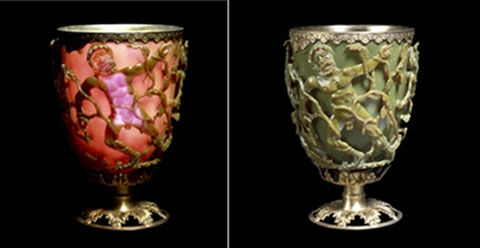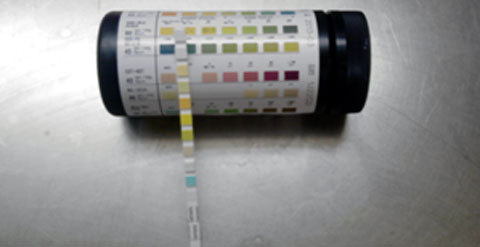Ancient Chalice Inspires New Physics
November 26, 2013
Although the Roman chalice shown below dates back to over 1600 years ago, it was recently the subject of some 21st century research.
When light shines directly on the chalice it appears jade green; when lit from behind, however, the chalice appears red. Researchers recently uncovered the reason behind this optical curiosity and are now seeking relevant applications.

The Lycurgus Cup backlit (left) revealing transmitted light and (b) frontlit (right) showing reflected light.
Image Credit and Copyright: The Trustees of the British Museum
The Myth
The chalice in question — called the Lycurgus Cup — was named for its depiction of King Lycurgus of Thrace entangled in grape vines. It depicts the myth that he was punished for attacking Dionysus, the god of wine and merriment, and Ambrosia, one of his followers.
In the myth, Ambrosia calls to Mother Earth, who turns her into a grape vine and, as a vine, Ambrosia captures Lycurgus. The chalice’s sculptor created the scene by carving and grinding into its thick glass held in metal mounts.2
The chalice is dichroic: It appears red when lit from behind and jade green when front lit. But for a long time scientists could not test the materials to determine why. In the 1990's, a group of scientists were able to explore some fragments of the glass and found small particles of silver and gold about 50 nm in diameter suspended in the glass. These metallic nanoparticles give rise to the different colors observed.
Color-Changing Chalice
When light strikes the Lycurgus Cup, it scatters off of the tiny (nano-sized) gold and silver particles. This optical scattering causes the reflected light to appear jade green and the transmitted light to appear red, when the cup is filled with air. For testing, scientists didn’t fill the original cup up with anything else. Instead, they have been observing miniature lab-made Lycurgus Cups, and these change colors when filled with different substances.
Scientists believe that this could have applications for colorimetric tests — tests whose end result is indicated by a different color. There are many tests that work in this way including home pregnancy tests and many urine tests.

A urine strip indicator to check for glucose, ketones, protein, pH, nitrite, and other factors
Image Credit: J3D3 via Wikimedia Commons
One recent study featured lab-made miniature Lycurgus Cups that, when filled with air, appear green when backlit and red when front lit. When these tiny cups are filled with salt water, sugar water, oil, and other substances, scientists have seen colors across the spectrum including green, yellow, orange, and red.1
Modern Applications
The Lycurgus Cup has inspired many scientists in nanoplasmonics, the study and application of surface plasmons. Surface plasmons are waves of free electrons in a metallic gas that can couple strongly with light on the nanoscale (billionths of a meter). Metal atoms’ outermost electrons easily move from one metal atom to another, and that is why they are called free electrons.
When there is a boundary layer between the metal atoms and another medium such as glass (an insulator), these oscillating free electrons can sustain the propagation of a visible electromagnetic wave along the interface boundary. These waves are called surface-plasmon-polaritons or SPPs.3 The color of light observed, has to do with the peak resonance wavelength maintained by the surface plasmons.
The researchers created an array of tiny Lycurgus Cups by imprinting holes (cups) in plastic (polyethylene terephthalate) ranging in height from 250 to 1000 nm, with various diameters. In addition, they used a technique known as electron beam evaporation to deposit a layer of silver or gold particles on the surface.1
The metallic deposition created a surface of metal on the bottom and on the rim of the tiny cups with nanoparticles on the sides.1 You can see a scanning electron microscope image of this in the first figure of the researchers' paper.
The scientists deposited different thicknesses of the metal. Their research paper focuses on cups of height 500 nm, diameter 180 nm, and metal deposits with a thickness of 90 nm since these values showed optimal sensitivity for their cups.1 The metal thickness affects the intensity of the transmitted light.
They looked at both the backlit and frontlit effects when their tiny cups were filled with different substances. For example, air filled cups appeared green when backlit and red when frontlit. When the cups are filled with ethanol they appear orange, with water they appear light green, and with immersion oil they appear red. Putting different materials inside these tiny cups causes the scattered light to be shifted in wavelength, and different colors are observed.
What's Next?
Some scientists foresee potential applications in biosensing, which was demonstrated in reference 1. The researchers were able to “visualize the colorless DNA and able to differentiate the concentration of DNA based on the color change of the sensor device.”1
The scientists also demonstrated protein-protein interactions for “therapeutic antibody screening,” and they demonstrated integration of these nano Lycurgus Cups into portable screening devices.1 The devices are inexpensive to create and have a high sensitivity, making them candidates for future drug and pathogen screening devices.
References and Resources
1. Gartia, M.R.. et al., “Colorimetric Plasmon Resonance Imaging Using Nano Lycurgus Cup Arrays,” Adv. Optical Mater. 2013, 1, 68-76http://onlinelibrary.wiley.com/doi/10.1002/adom.201370001/abstract
2. The Lycurgus Cup, The British Museum
http://www.britishmuseum.org/explore/highlights/highlight_objects/pe_mla/t/the_lycurgus_cup.aspx
3. Nanoplasmonics Summary, NIST
http://www.nist.gov/cnst/nrg/nanoplasmonics.cfm
—Heide Doss














